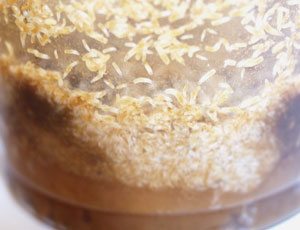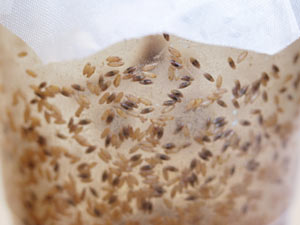Fruit flies are an excellent food for many surface feeding killifish, closely resembling their natural diets in the wild. They are easy to culture, quickly, cheaply and in large numbers. Fruit flys are rarely available in pet shops, but are widely available online, and very much worth trying, even if you don't bother culturing them on an ongoing basis.
What is a fruit fly?
Fruit flies are small flies that live on and around decaying fruit and vegetation. They occur worldwide, except the very coldest regions. The species most familiar to scientists, aquarists and herpetologists are in the genus Drosophila which literally means 'dew-lover' in Greek. Also known as 'bar fly' or 'vinegar fly', these little flies are commonly found around waste bins, bars, orchards etc, and they are widely used in laboratories as research animals. The species we feed to our fish however, have been bred to have shorter 'vestigial' wings, and as such can not fly. These are typically from two species Drosophila melanogaster and Drosophila Hydei.
Why fruit flies?
Although dealing with highly mobile flies can be trickier than with worms, there are some great reasons to consider culturing them.
- Nutritious - all fish can be trained to eat flies, but surface feeders love them. Not only are they relished by the fish, but they also have a high fibre content, and are therefore a great contrast to the fattier foods such as worms and beef heart. They are also typically disease-free, unlike some aquatic livefoods.
- Prolific An adult fly can lay 20+ eggs in a day. Once you get the hang of it, fruit flies are easy to maintain, and at 25 deg. centigrade the development of Drosophila melanogaster takes just 9 days.
- Availability - unlike collected livefoods, cultured Drosophila are available all year round.
- Flightless flies available - fruit flies have been studied in laboratories for very many years, and a lot is known about the humble fruit fly. Over the course of these studies, geneticists line-bred many strains of fly, including vestigial-winged, and even wingless flies. These are the flies typically cultured by hobbiests.

Drosophila larvae in a typical culture

Drosophila larvae climb up the walls of their vials and chrysalise

Drosophila pupae
Drosophila life cycle
Adult flies lay a lot of eggs. A single female can lay over 20 eggs in a day, and can store sperm within her body for up to two weeks, to lay fertilized eggs at will.
Eggs take 23 hours to hatch at 25 deg C. Once they do hatch, the larvae bury into the media and grow. They will stay as larvae for five days, in which time they undergo three moults.
Eventually they will start to climb the sides of the vial, and when fully grown will settle near the top, and form a chrysalis. The change from maggot to fly takes around three days, but again, is temperature dependent.
The image to the right shows a newly formed chrysalis with the lava's segments still visible (1), an older chrysalis with the fly clearly visible. The red dots are its eyes (2) and an empty chrysalis from which a fly will have hatched (3).
Once the flies have emerged they must be moved to new vials, as there is now no food suitable for them in the old vials.
Fruit fly cultures for sale
Killi.co.uk is funded by its visitors. When you buy through links on our site we may earn an affiliate commission. For more info see
terms and conditions.
Wheeling, Illinois, 600**, UNITED STATES OF AMERICA
$36
Fruit fly Media Culture Mix Kit contains 1 5Lb (24oz) Of Media Excelsior, Cups / Lids to makes 10 fruit flies cultures.
It does not include live flies
Our fruit fly media works for both melanogaster and Hydei. It is Homemade with the best ingredients to produce top quality flies for your animals . Our fruit fly media contains brewer's years vitamins B also ingredients anti-bacterial to avoid the bad smell, we use a mold inhibitor to prevent mold. The ingredients we use give increase ...
more
San Juan, Puerto Rico, 009**, UNITED STATES OF AMERICA
$15
Flightless Fruit Fly Culture (Drosophila Melanogaster) Free Shipping
Ship Monday-Wednesday
Live arrival guaranteed
Any question or problem send me a message
...
more
Eureka, California, 955**, UNITED STATES OF AMERICA
$16
Fresh, healthy fruit fly cultures grown on a premium, nutrient-rich medium for strong growth and reliable production
Each culture is started with a generous number of flies to ensure quick establishment and steady output
Perfect For:
?? Dart frogs & tree frogs
?? Baby chameleons
?? Small geckos (crested, gargoyle, day geckos, leachies)
?? Praying mantises & jumping spiders
?? Betta & nano fish
?? Isopods, springtails, & bioactive tanks love spent ...
more
Ogden, Utah, 844**, UNITED STATES OF AMERICA
$15
Flightless Fruit Fly Culture (Drosophila Melanogaster). Condition is New. These flightless fruit fly cultures come in a 32oz cup with a ventilated lid, excelsior wool and culture mix. It will come with 100 adult flys that will already be laying new generations upon arrival. For best practices, do not use flys until 5 days after first generation hatches to ensure new generation. These cultures will last you several weeks. Shipped with USPS First Class
...
more
Lyndhurst, New Jersey, 070**, UNITED STATES OF AMERICA
$13
Melanogaster Fresh Fruit Fly Cultures and they are an ideal food for Poison Dart Frogs, fish, Praying Mantids, young frogs and toads, and other reptiles, amphibians, or captive animals that require small foods....
more


